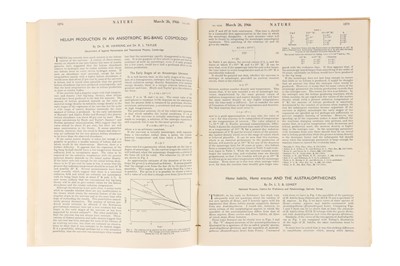24th May, 2023 12:00
Fine Instruments of Science, Medicine and Books
Stephen Hawking, Helium Production in an Anisotropic Big-Bang Cosmology
Two volumes including:
Nature A Weekly Journal of Science, Volume 209, No. 5030, March 26 1966, London, Macmillan (Journals) ltd, original orange wrappers, with first edition, first impression of Dr. Stephen Hawking and Dr. R. J Taylor’s paper: Helium Production in an Isotropic Big-Bank Cosmology [p.1278 – p.1279]
Stephen Hawking's First Published Research in Nature - Stephen Hawking was one of the most brilliant and influential physicists of the 20th century, famous for his groundbreaking work in cosmology and the nature of space and time. In March 1966, when Hawking was just 24 years old, he published his first piece of research in the prestigious journal Nature. This paper, titled "Helium Production in an Anisotropic Big-Bang Cosmology," would become a milestone in the history of cosmology, and here's why.
At the time of Hawking's research, the Big Bang Theory, which proposes that the universe began as an extremely hot and dense state and has been expanding since then, was still a relatively new concept. But the theory had already proven to be promising, as it explained the abundance of the elements in the universe, including helium. The problem, however, was that the standard Big Bang model predicted too much helium compared to what was actually observed. Hawking's paper addressed this issue.
One of the key insights Hawking had was that the early universe was not completely uniform, but had some degree of anisotropy, meaning that it had some variation in density or temperature. Hawking showed that if the early universe had a certain amount of anisotropy, it could explain the observed abundance of helium, resolving the discrepancy between theory and observation.
Hawking's paper was significant not only because it provided a solution to an outstanding problem in cosmology but also because it demonstrated his exceptional talent as a physicist. The paper showed that even as a young researcher, Hawking had an innate ability to think creatively and see connections between apparently disparate fields. Moreover, it foreshadowed the innovative and influential contributions Hawking would later make in fields such as black holes and quantum gravity.
In conclusion, Stephen Hawking's first published research in Nature, "Helium Production in an Anisotropic Big-Bang Cosmology," was an important milestone in the history of cosmology. It addressed a key problem in the standard Big Bang model and demonstrated Hawking's exceptional talent and potential as a physicist. The paper remains a testament to Hawking's enduring legacy as one of the most brilliant and influential scientists of the past century.
Two volumes including:
Nature A Weekly Journal of Science, Volume 209, No. 5030, March 26 1966, London, Macmillan (Journals) ltd, original orange wrappers, with first edition, first impression of Dr. Stephen Hawking and Dr. R. J Taylor’s paper: Helium Production in an Isotropic Big-Bank Cosmology [p.1278 – p.1279]
Stephen Hawking's First Published Research in Nature - Stephen Hawking was one of the most brilliant and influential physicists of the 20th century, famous for his groundbreaking work in cosmology and the nature of space and time. In March 1966, when Hawking was just 24 years old, he published his first piece of research in the prestigious journal Nature. This paper, titled "Helium Production in an Anisotropic Big-Bang Cosmology," would become a milestone in the history of cosmology, and here's why.
At the time of Hawking's research, the Big Bang Theory, which proposes that the universe began as an extremely hot and dense state and has been expanding since then, was still a relatively new concept. But the theory had already proven to be promising, as it explained the abundance of the elements in the universe, including helium. The problem, however, was that the standard Big Bang model predicted too much helium compared to what was actually observed. Hawking's paper addressed this issue.
One of the key insights Hawking had was that the early universe was not completely uniform, but had some degree of anisotropy, meaning that it had some variation in density or temperature. Hawking showed that if the early universe had a certain amount of anisotropy, it could explain the observed abundance of helium, resolving the discrepancy between theory and observation.
Hawking's paper was significant not only because it provided a solution to an outstanding problem in cosmology but also because it demonstrated his exceptional talent as a physicist. The paper showed that even as a young researcher, Hawking had an innate ability to think creatively and see connections between apparently disparate fields. Moreover, it foreshadowed the innovative and influential contributions Hawking would later make in fields such as black holes and quantum gravity.
In conclusion, Stephen Hawking's first published research in Nature, "Helium Production in an Anisotropic Big-Bang Cosmology," was an important milestone in the history of cosmology. It addressed a key problem in the standard Big Bang model and demonstrated Hawking's exceptional talent and potential as a physicist. The paper remains a testament to Hawking's enduring legacy as one of the most brilliant and influential scientists of the past century.


